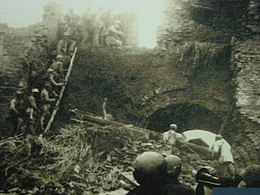This article includes a list of references, related reading, or external links, but its sources remain unclear because it lacks inline citations. (July 2017) |
| Shangdang Campaign | |||||||
|---|---|---|---|---|---|---|---|
| Part of the Chinese Communist Revolution | |||||||
 | |||||||
| |||||||
| Belligerents | |||||||
|
| |||||||
| Commanders and leaders | |||||||
|
|
| ||||||
| Units involved | |||||||
|
|
| ||||||
| Strength | |||||||
| ~35,000 | ~80,000 | ||||||
| Casualties and losses | |||||||
| 35,000, most of them captured | 4,708 killed | ||||||
The Shangdang Campaign (simplified Chinese: 上党战役; traditional Chinese: 上黨戰役) was a series of battles fought between Eighth Route Army troops led by Liu Bocheng and Kuomintang troops led by Yan Xishan (aka Jin clique) in what is now Shanxi Province, China. The campaign lasted from 10 September 1945, through 12 October 1945. Like all other Chinese Communist victories in the clashes immediately after Imperial Japan's surrender in World War II, the outcome of this campaign altered the course of the peace negotiation held in Chongqing from 28 August 1945, through 11 October 1945, resulting in a more favourable outcome for Mao Zedong and the party.